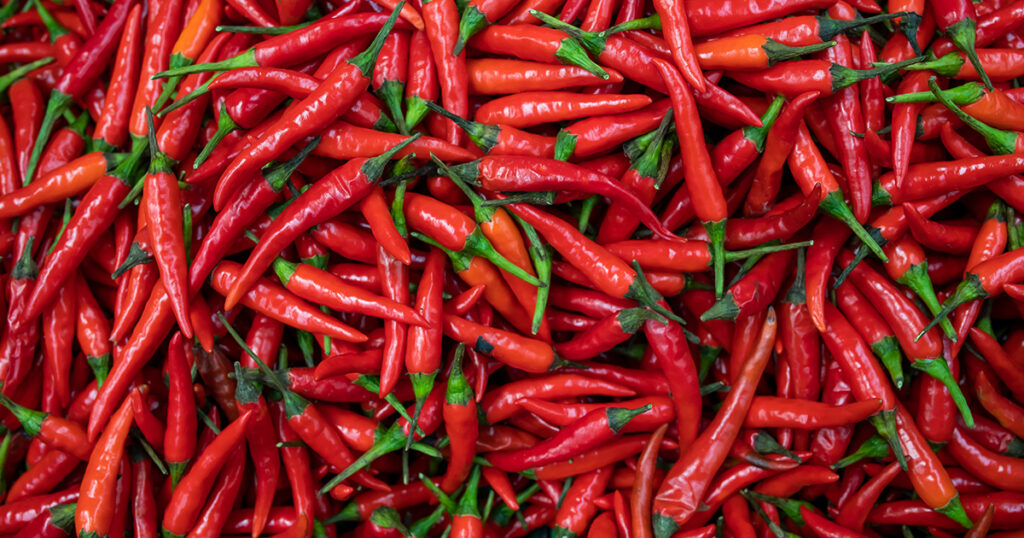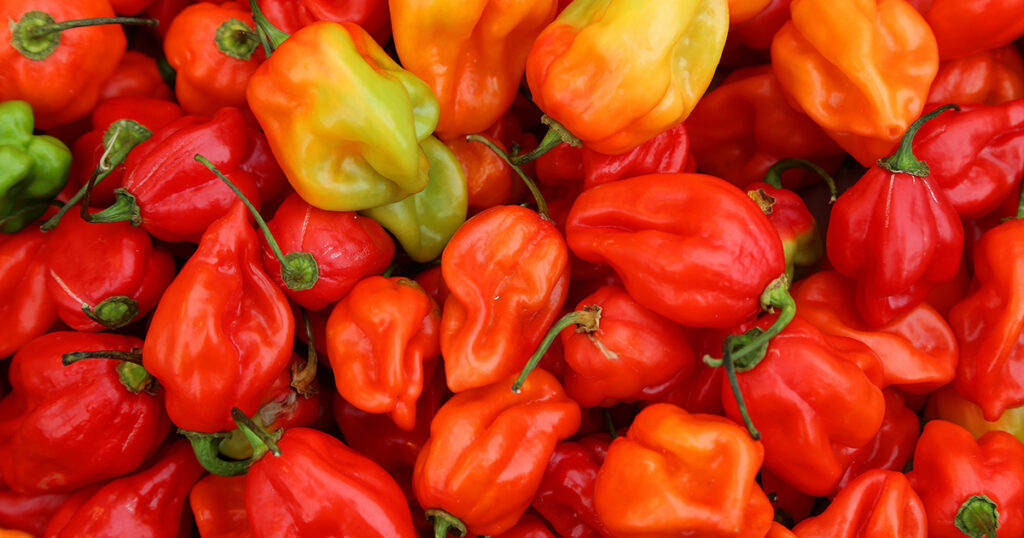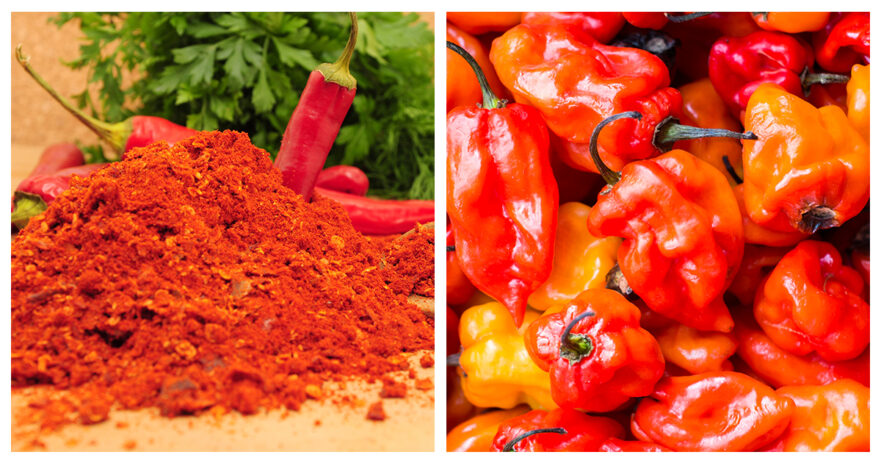Peppers have always held a revered spot in culinary traditions around the globe, serving as both flavor enhancers and key ingredients in various dishes. The cayenne pepper and habanero are prominent in the vast spectrum of chili peppers. While they share the common trait of adding a spicy kick to meals, each has unique characteristics and nuances.
This guide sheds light on the differences and similarities between these two popular chili peppers. Whether you’re an aspiring chef, a food enthusiast, or someone keen on spicing up their culinary journey, this article will help you understand when to use cayenne pepper or habanero to achieve the desired taste and heat.
Table of contents
What is Cayenne Pepper?

Cayenne pepper is a well-known spicy chili pepper used to flavor dishes in cuisines worldwide. Belonging to the Capsicum genus, this pepper owes its name to the city of Cayenne in French Guiana.
The pepper is slender and red, typically dried and ground to produce the powdered spice we often see in stores. Its distinct fiery heat comes from capsaicin, which offers numerous health benefits and is responsible for the burning sensation we associate with spicy foods.
Measured on the Scoville scale, cayenne peppers have a heat rating that typically ranges from 30,000 to 50,000 Scoville Heat Units (SHU), placing them in the medium-hot category of peppers. While they’re not as hot as some of their chili counterparts, like the habanero, they still pack a considerable punch.
In the culinary world, cayenne pepper is celebrated for its versatility. It’s a staple in many spicy dishes, especially Mexican and Cajun cuisines. The pepper can be used fresh, but it’s often dried and ground into a fine powder, which makes it easy to sprinkle over dishes or incorporate into recipes. Its vibrant red color adds a visual appeal to dishes, making it a favorite among chefs and home cooks.
What is Habanero?

The habanero pepper, known for its fiery heat and distinctive fruity flavor, holds a special place in the hearts of spice lovers. Originating from the Amazon basin, it made its way to Mexico and, from there, spread to various parts of the world. Recognizable by its lantern-like shape, the habanero boasts a variety of colors, including orange, red, and occasionally yellow and chocolate.
When it comes to spiciness, the Habanero doesn’t disappoint. Rated on the Scoville scale, its heat ranges from a scorching 100,000 to 350,000 Scoville Heat Units (SHU). This makes the habanero one of the hottest chili peppers readily available to consumers. But beyond its intense heat, the habanero offers a sweet, tropical fruitiness that lends a unique flavor profile to dishes.
In terms of culinary applications, the habanero is a star. This pepper is versatile, from being a key ingredient in traditional Caribbean dishes to lending its heat to salsas, sauces, and marinades. Its fruity undertones balance its intense heat, making it a sought-after pepper for those wanting a fiery yet flavorful experience.
When cooking with habaneros, caution is advised; its potency can quickly overpower a dish. It’s always a good idea to start with a small amount and adjust according to preference.
What are the Similarities Between Cayenne Pepper and Habanero?
Cayenne pepper and habanero hail from the esteemed Capsicum genus and have firmly established their importance in global culinary landscapes. Originating from the rich soils of Central and South America, these chili peppers have journeyed across continents, finding their way into diverse culinary traditions and becoming indispensable in numerous recipes.
Their primary function in dishes is unmistakable: introducing that coveted heat and enhancing the overall flavor profile. Whether it’s a tempting main course or a fiery side dish, these peppers are a chef’s trusted ally, consistently delivering that spicy kick many crave.
Another shared characteristic is their prominence in the world of hot sauces. The robust heat of the cayenne and habanero is frequently tapped into to concoct spicy hot sauces that leave a lasting impression on the palate. When it comes to their rating on the Scoville scale, both stand tall in the hot category, asserting their dominance in the realm of spicy chili peppers.
However, with great power comes great responsibility. Handling these potent peppers demands caution. Due to their high capsaicin content, which gifts them their spiciness, they can cause irritation. Wearing gloves during preparation is a wise move, and it’s crucial to remember the golden rule: steer clear of touching the face, especially the eyes, after handling.
What are the Differences Between Cayenne Pepper and Habanero?
The world of chili peppers is vast and diverse, and within its realm, both cayenne pepper and Habanero command attention. However, despite their shared lineage, they exhibit distinct characteristics. One of the most glaring differences is their heat intensity. Cayenne peppers typically register between 30,000 to 50,000 SHU on the Scoville scale, whereas habanero can skyrocket from 100,000 to 350,000 SHU. This discrepancy translates to a much spicier experience with the habanero.
Flavor-wise, while both peppers are known to enhance dishes with their spiciness, they have different taste profiles. Cayenne peppers offer a straightforward spicy kick, while habaneros introduce a delightful fruity undertone. This citrusy hint makes habaneros particularly intriguing for recipes that benefit from a mix of sweet and spicy elements, providing a complexity that’s hard to replicate.
Visually, the two peppers are easily distinguishable. Cayenne peppers are usually slender and red, often dried and ground into powder. In contrast, habanero peppers, known for their lantern-like shape, come in various colors, from bright orange and fiery red to more subdued yellows and even chocolate shades.
Lastly, their roles in the culinary world diverge. Cayenne is a versatile powerhouse, finding its place in many dishes across different cuisines. On the other hand, habanero, with its unique combination of heat and fruitiness, is a favorite in Caribbean cuisine and a key player in many hot sauces.
FAQ about cayenne pepper and habanero
Is cayenne pepper hotter than habanero?
In the world of chili peppers, the cayenne pepper is notably spicy, but the habanero stands out as considerably hotter. On the Scoville scale, cayenne peppers have a rating between 30,000 to 50,000 SHU. In contrast, habaneros boast a fiery range of 100,000 to 350,000 SHU, making them significantly spicier than cayenne peppers.
Is cayenne pepper hotter than jalapeño?
When compared to jalapeño, the cayenne pepper is generally hotter. While jalapeños range from 2,500 to 8,000 SHU on the Scoville scale, cayenne peppers possess a spicier heat rating of 30,000 to 50,000 SHU. Hence, dishes seasoned with cayenne tend to have a more intense kick than those flavored with jalapeños.
Is cayenne pepper the spiciest?
While the cayenne pepper is notably spicy, especially in the world of chili peppers, it isn't the spiciest. Several peppers, such as the habanero, Carolina Reaper, and Trinidad Moruga Scorpion, have much higher ratings on the Scoville scale. Cayenne peppers fall in the medium-hot category with a heat range of 30,000 to 50,000 SHU.
How spicy is cayenne pepper?
The cayenne pepper is renowned for its spicy kick in culinary dishes. Rated on the Scoville scale, cayenne peppers typically measure between 30,000 to 50,000 SHU, placing them in the medium-hot category of chili peppers. Their distinct fiery heat comes from capsaicin, the compound responsible for the burning sensation associated with spicy foods.
How hot is habanero?
The habanero is among the hottest chili peppers readily available to consumers. On the Scoville scale, its heat can range from a scorching 100,000 to 350,000 SHU. Beyond its intense heat, habaneros also offer a unique, sweet, tropical fruitiness, distinguishing them from other chili peppers and providing a fiery yet flavorful experience.

